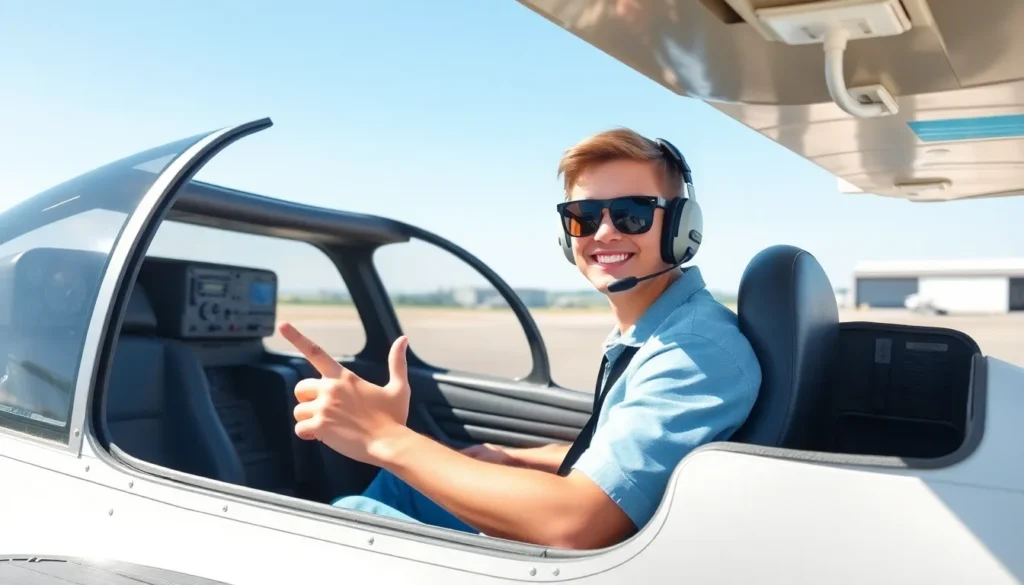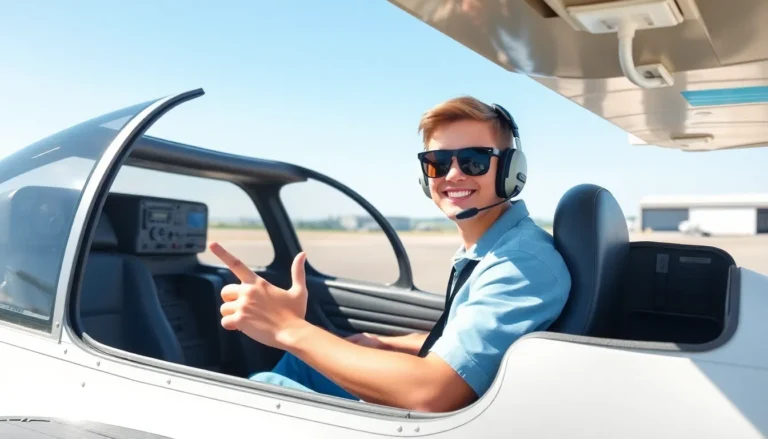So you’ve always dreamed of soaring through the skies, wind in your hair and clouds beneath your wings. But before you start practicing your best “Roger that” on the radio, there’s one little detail you need to nail down: age. Yes, it turns out you can’t just hop into the cockpit with a pocket full of dreams and a heart full of adventure.
Table of Contents
ToggleUnderstanding Pilot Age Requirements
Aspirants for a pilot license must meet specific age criteria set by aviation authorities. Detailed below are the age requirements based on the type of pilot license sought:
- Private Pilot License (PPL): An individual must be at least 17 years old. This age allows for adequate time and training to acquire necessary skills and knowledge for recreational flying.
- Commercial Pilot License (CPL): An individual must be at least 18 years old. This requirement ensures that pilots possess enough maturity and experience to handle commercial responsibilities.
- Airline Transport Pilot License (ATPL): An individual must be at least 23 years old. This age ensures pilots have extensive flying experience, validating their capability to command large aircraft.
Training institutions and flight schools may impose additional age limits for enrollment in their programs. For instance, some schools may accept students younger than the licensing age, permitting them to complete ground school or simulator training, but they cannot log flight hours until reaching the minimum age.
Age may also influence the ability to secure medical certificates required for flying. The Federal Aviation Administration (FAA) mandates that prospective pilots pass medical examinations, which vary in strictness based on the class of medical certification sought.
Understanding these age requirements is crucial for aspiring pilots as they navigate the pathway to their aviation goals. Meeting these criteria allows them to plan their training timeline effectively and ensures compliance with regulatory standards.
Minimum Age for Different Types of Pilots

Understanding the minimum age requirements for various pilot licenses is essential for aspiring aviators. Different categories exist, each with specific age regulations to follow.
Private Pilot
To obtain a Private Pilot License (PPL), candidates must be at least 17 years old. This age requirement allows individuals to undergo flight training and accumulate the necessary flight hours. PPL holders can fly solo or with passengers under visual flight rules, though they cannot operate for compensation or hire. Aspiring pilots should also pass a medical examination and demonstrate proficiency in both ground school and flight training.
Commercial Pilot
The age requirement for a Commercial Pilot License (CPL) is 18 years old. At this age, pilots can pursue advanced flight training, which includes specific maneuvers and longer solo flights. A CPL enables holders to earn compensation for their flying services. Candidates must still pass a medical examination and accumulate additional flight hours beyond those required for a PPL, often including night and cross-country flights.
Airline Transport Pilot
To become an Airline Transport Pilot (ATPL), individuals must be at least 23 years old. This license signifies the highest level of pilot certification, permitting individuals to serve as captains for airlines. Candidates must complete extensive training, accumulate a significant amount of flight experience, and pass rigorous testing. The ATPL ensures that pilots have the skills and knowledge necessary to operate commercial aircraft safely in various conditions.
Factors Affecting Age Requirements
Multiple factors influence the age requirements for becoming a pilot. Understanding these elements helps aspiring pilots navigate their path effectively.
Regulatory Guidelines
Aviation authorities enforce specific age restrictions for various pilot licenses. The Federal Aviation Administration (FAA) in the United States outlines these limits. Aspiring private pilots must reach the age of 17, while commercial pilots must be at least 18. For airline transport pilots, the minimum age increases to 23. These regulations ensure that pilots possess the maturity and judgment necessary for safe operations. Additionally, each country’s aviation authority may implement different age rules, impacting regional training programs.
Training and Education
Training institutions often impose their own age criteria alongside regulatory standards. Many flight schools begin accepting students at 15 or 16, enabling young enthusiasts to start their training early. However, students must still meet the legal minimum age before obtaining their pilot licenses. Additionally, age affects candidates’ eligibility for medical certificates, which are essential for flight operations. Schools may also consider the age of trainees regarding their ability to complete training in a timely manner, influencing enrollment decisions.
Additional Considerations
Age requirements for aspiring pilots involve additional factors that play a critical role in their training journey.
Medical Examinations
Medical examinations serve as a crucial step for anyone pursuing a pilot license. The Federal Aviation Administration (FAA) mandates that pilots obtain a medical certificate from an authorized aviation medical examiner. Candidates must generally be at least 16 years old for a first-class medical certificate, which is required for commercial and airline transport pilots. It’s essential for medical applicants to demonstrate overall health, encompassing vision and hearing standards along with mental and physical fitness. Prior health issues may affect eligibility, and individuals should be aware that different classes of medical certificates have varying requirements, impacting their training progression based on age.
Flight Hours and Experience
Flight hours represent a significant component of pilot training and licensing. Aspiring pilots accumulate hours under supervision to meet specific requirements mandated by different licenses. For a Private Pilot License (PPL), a minimum of 40 flight hours is necessary, whereas a Commercial Pilot License (CPL) typically requires a minimum of 250 hours. These flight hours must include specific types of flying experiences, such as solo flights and cross-country navigation. Younger candidates who start their training earlier may have more time to accumulate these hours. However, acquiring experience often leads to skill development, ensuring pilots meet necessary competency levels by the time they reach the required age for final certification.
Pursuing a career as a pilot is an exciting journey filled with opportunities. Understanding the age requirements is vital for aspiring aviators as they plan their training and career paths. With specific age thresholds for various licenses like the PPL, CPL, and ATPL, candidates can better navigate their training timelines.
Starting flight training at a younger age can provide a significant advantage in accumulating flight hours and experience. Additionally, meeting medical certification requirements is crucial for ensuring safety and compliance. By grasping these age-related factors, aspiring pilots can set themselves up for success in the aviation industry.





